Physical Address
304 North Cardinal St.
Dorchester Center, MA 02124
Vascular neoplasms and proliferations in this chapter are mainly made up of endothelial cells that line blood vessels or lymphatics. These cells are generally positive for factor VIII-related antigen, Ulex europaeus lectin, CD31, CD34, FLI-1, and ERG.
(see Fig. 25.1A–G )
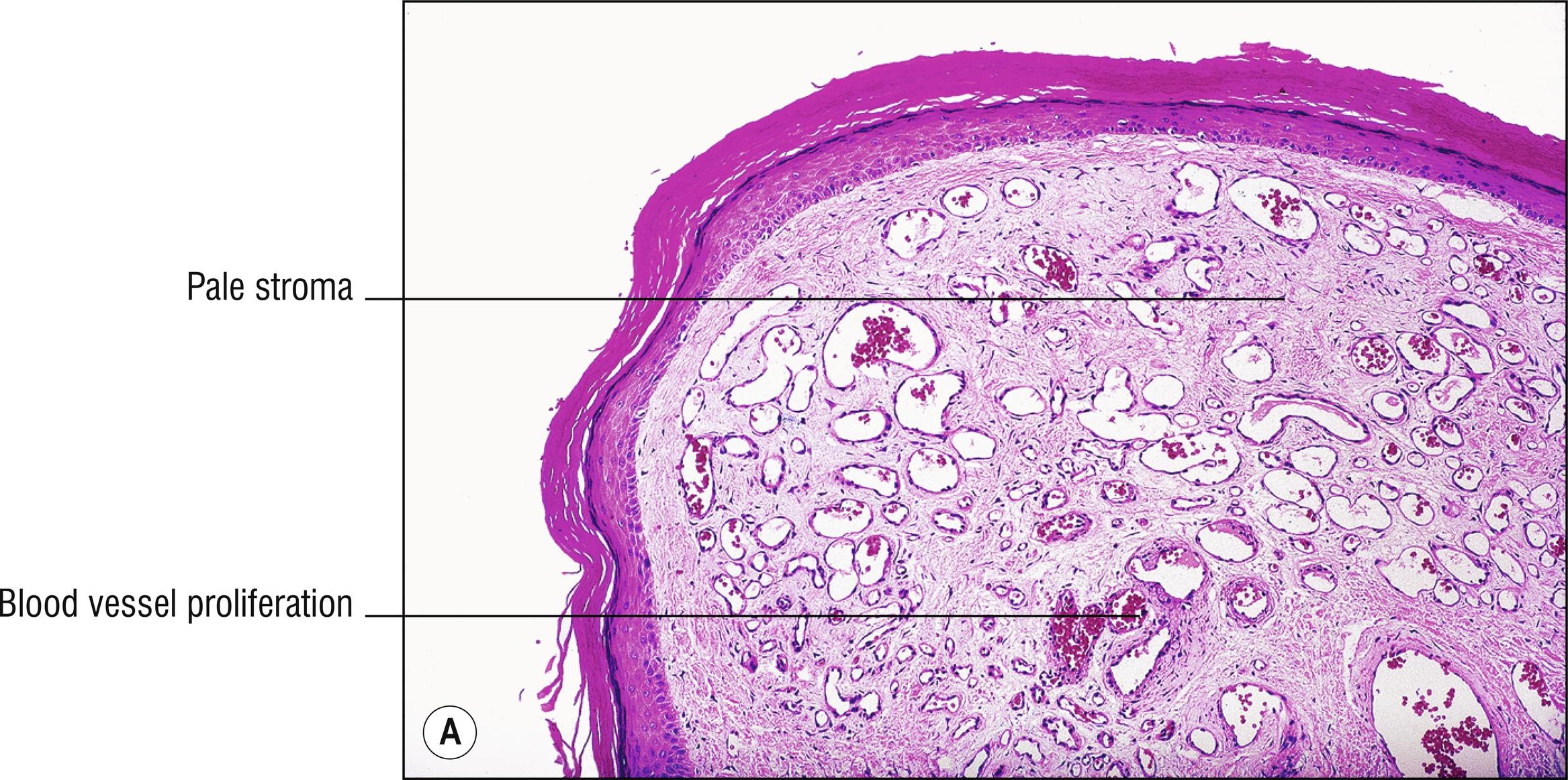
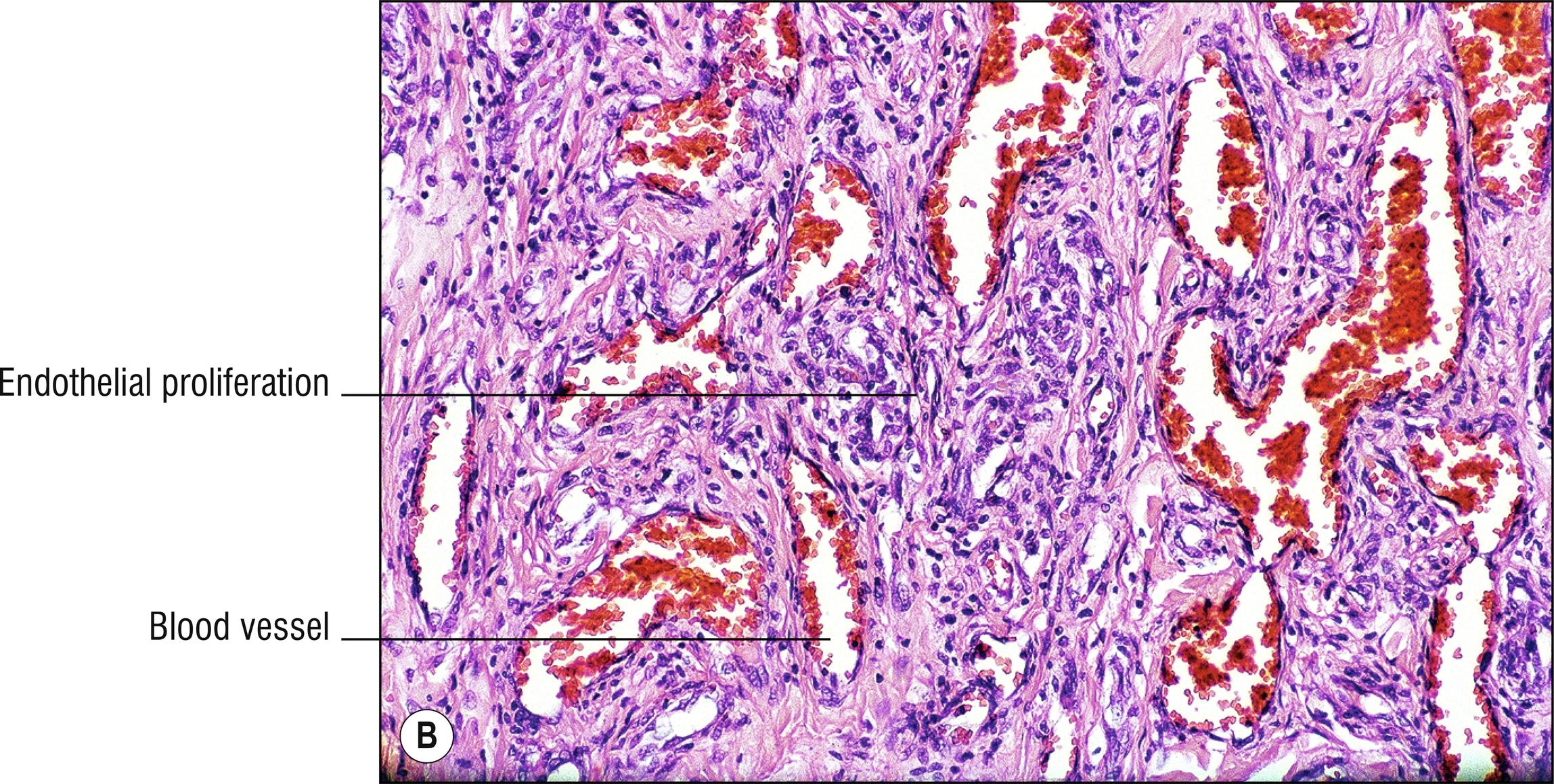
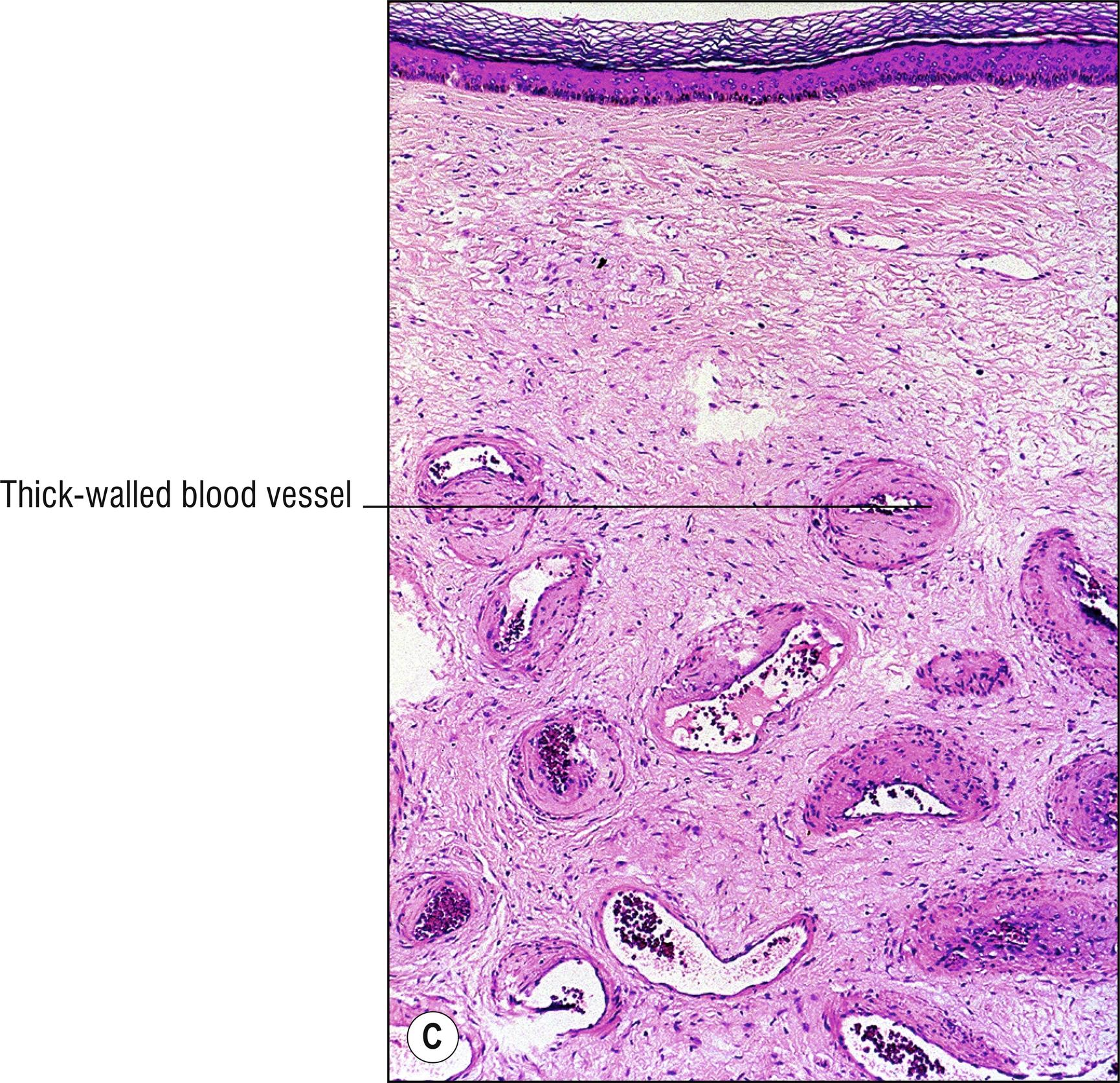
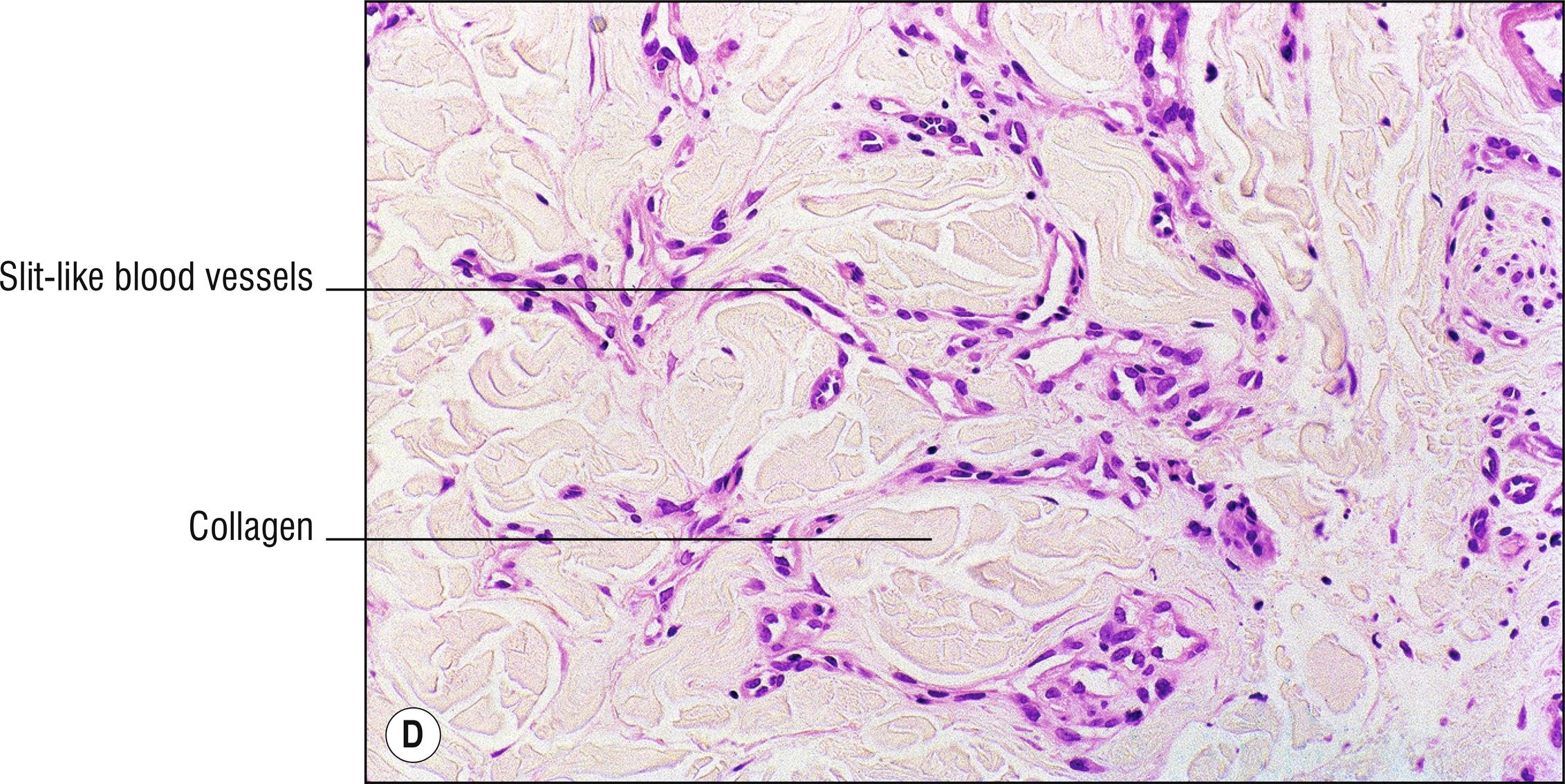
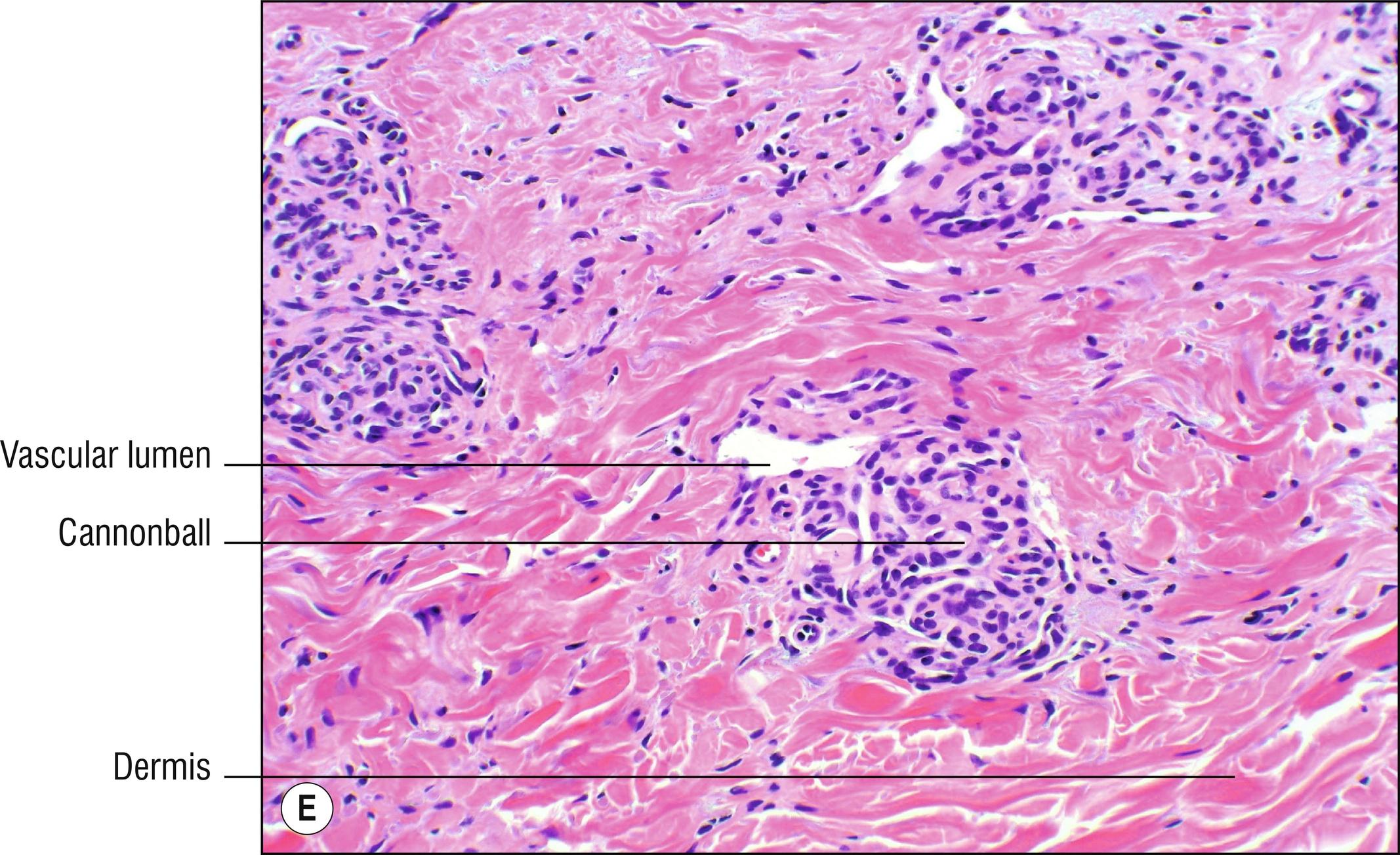


Pediatric dermatologists split most vascular neoplasms into two groups, true hemangiomas and vascular malformations, based upon the tendency of true hemangiomas in childhood to proliferate and then involute spontaneously, while vascular malformations persist. This is a somewhat artificial classification, because many mixed lesions may be found. Other dermatologists tend to use the term hemangioma more loosely for most benign vascular neoplasms. They also tend to drop the prefix “heme” and call very small lesions “angiomas!” Even smaller vascular dilations are called telangiectasias (1.136). Most hemangiomas are red macules , plaques or nodules (1.121), but some may be bluish (1.14).
Epidermis usually normal or atrophic
Proliferation of blood vessels and endothelial cells
GLUT-1 positive in proliferating and involuting infantile hemangiomas (and placentas), negative in other vascular neoplasms, vascular malformations, non-involuting congenital hemangioma (NICH), and rapidly involuting congenital hemangioma (RICH). Claudin-1 and Wilms tumor 1 (WT1) more likely to be positive in infantile hemangiomas and negative in vascular malformations, but results have been imperfect
Infantile hemangioma (IH, historically called strawberry hemangioma): origin at birth or soon after, classically with proliferative phase, and involution phase, usually largely scarred by age 7 years. Nodules or plaques may become very large, histologically with more endothelial proliferation. Younger proliferative lesions may resemble angiosarcoma, whitish fibrosis in involuting lesions .
NICH and RICH appear to be distinct from IH. RICH proliferates in utero, without an arteriovenous fistula, and rapidly resolves within 2 years. NICH proliferates rapidly, with large thin-walled vessels with stellate lumina and arteriovenous fistulae,but does not involute and is more likely to need surgical excision.
Cherry hemangioma: very common, adults after age 30 years, small papule usually less than 5 mm, often multiple, most common on the trunk (1.141), small vessels proliferate.
Verrucous hemangioma: onset in childhood, most common on legs, verrucous epidermis, with dermal vascular proliferation more likely to be a malformation.
Nevus flammeus: red or purple macule , includes the congenital salmon patch (“stork bite”) of the posterior scalp, which may involute, and the port-wine stain on the face (1.44) which usually persists.
Cavernous hemangioma: onset soon after birth, extensive , deep dilated vessels in the dermis and subcutaneous tissue.
Arteriovenous hemangioma (cirsoid aneurysm): face (1.44) or acral skin of adults, solitary small papule , thick-walled vessels , localized to the dermis.
Glomeruloid hemangioma: multiple red to purple papules on the trunk or extremities of adults, especially Japanese, associated with POEMS syndrome (24.12), or Castlemańs syndrome (giant lymph node hyperplasia), small capillaries protrude into a dilated vascular space resembling a glomerulus , with plump endothelial cells having PAS-positive hyaline globules containing immunoglobulins or cryoproteins. It may be reactive rather than neoplastic and is similar to reactive angioendotheliomatosis (see below).
Tufted hemangioma (angioblastoma of Nakagawa): childhood red macule or plaque, most common on the neck or upper trunk, associated with Kasabach–Merritt syndrome (see below), “ cannonball “ clusters of glomeruloid capillary proliferations separated by normal dermis. Positive for Prox1, unlike infantile hemangioma.
Kaposiform hemangioendothelioma (KHE): childhood aggressive violaceous , purpuric plaque (1.148), high mortality if not treated, associated with Kasabach–Merritt syndrome like the tufted hemangioma, thrombosed capillaries (1.137), and slit-like vascular spaces . Positive for Prox1, negative for Glut-1, unlike infantile hemangioma.
Microvenular hemangioma: adults, solitary plaque mostly on extremities, small slit-like spaces dissect through the dermis, and may not be readily recognized as vascular spaces (CD31 +, CD34 +), may resemble Kaposi sarcoma (25.9). Pericytes around the endothelial cells often SMA +. May occur in healthy adults, pregnancy, or POEMS syndrome (24.5).
Neonatal hemangiomatosis: multiple congenital hemangiomas involving three separate organ systems .
Sturge–Weber syndrome: port-wine stain associated with ipsilateral brain lesions.
PHACES (PHACE) syndrome: P osterior fossa malformations (Arnold–Chiari and Dandy–Walker), H emangiomas (large cervicofacial or laryngeal), A rterial anomalies (carotid, cerebral, vertebral C ardiac defects), E ye abnormalities, S ternal or abdominal clefting.
PELVIS syndrome: perineal hemangioma with external genital abnormalities, lipomyelomeningocele, renal or bladder abnormalities, imperforate anus, or acrochordon.
Kasabach–Merritt syndrome: bleeding diathesis associated with platelet trapping in children having tufted hemangioma or kaposiform hemangioendothelioma.
Klippel–Trenaunay–Weber syndrome: hypertrophy of a limb associated with a hemangioma or vascular malformation.
Maffucci syndrome: sporadic mutation in IDH1 or IDH2 gene, multiple enchondromas and osteochondromas associated with vascular malformation (often spindle cell hemangioma).
Blue rubber bleb nevus syndrome: soft bluish papules or nodules associated with GI hemangiomas (1.49).
Reactive angioendotheliomatosis: purpuric red macules (1.120), papules or plaques, or reticulated erythema, reacting to infection or cryoglobulinemia (4.9), but usually idiopathic, with lobular proliferations of capillaries in the dermis, thrombi (1.137), and endothelial cells that occlude the lumina . It is not to be confused with malignant angioendotheliomatosis, which is now called intravascular lymphoma (24.13). Intravascular histiocytosis has been considered a form of reactive angioendotheliomatosis.
Diffuse dermal angiomatosis: variant of reactive angioendotheliomatosis, mostly on trunk or extremities, especially pendulous breasts with skin ulcerations, associated with peripheral vascular disease, chronic renal disease, diabetes mellitus, and antiphospholipid antibody syndrome. There is endothelial proliferation which may resemble microvenular hemangioma or lymphangiosarcoma.
Acquired elastolytic hemangioma; upper limbs or neck of elderly patients, slowly growing red plaques, vascular proliferation in dermis with solar elastosis
Angiokeratoma (25.2): epidermal hyperplasia, vessels more dilated without endothelial proliferation.
Pyogenic granuloma (25.3): often related to trauma, more inflammation, pale stroma, and often ulcerated.
(see Fig. 25.2A–D )




Uncommon solitary or multiple red, purple (1.148), or black (1.13) papules or plaques.
Hyperkeratosis, epidermal rete ridges often encircle dilated vessels
Dilated vessels in superficial dermis, without much endothelial proliferation
Thrombi common (1.137)
Angiokeratoma of Mibelli: dorsal fingers and toes (1.56); arises in childhood .
Angiokeratoma scroti of Fordyce: scrotum (1.126, and rarely of vulva) of adults.
Papular angiokeratoma: solitary or multiple small papules in adults, especially on the legs (1.67).
Angiokeratoma circumscriptum: larger lesion, usually extremities, deeper vessels; arises at birth or early in childhood.
Angiokeratoma corporis diffusum (Fabry’s disease): X-linked recessive, alpha-galactosidase deficiency (commercially available test) related to mutation in the GLA gene, resulting in trihexosylceramide accumulation in several organs, bathing trunk distribution of many small angiokeratomas, painful peripheral neuritis , no hyperkeratosis, small lipid deposits in endothelial cells (PAS positive, frozen sections positive with Sudan black B, birefringent under polarized light; visible with electron microscopy).
Beta-galactosidase deficiency: very rare, similar to Fabry’s disease.
Fucosidosis: very rare autosomal recessive disorder, alpha-fucosidase deficiency, related to mutation in the FUCA1 gene, similar to Fabry’s disease.
Targetoid hemosiderotic hemangioma: usually solitary red–brown macule or barely elevated plaque in an adult, sometimes with annular target appearance (1.5), no hyperkeratosis, superficial dilated vessels, with deeper dissecting slit-like vascular channels. Plump “hobnail” endothelial cells protrude into lumen of the dilated vessels, hemosiderin (1.58) and erythrocyte extravasation (1.40) common, may mimic Kaposi sarcoma (25.9). The term hobnail hemangioma has been proposed as a synonym for targetoid hemosiderotic hemangioma, but unfortunately hobnail endothelial cells have also been used to describe angiolymphoid hyperplasia (25.4), retiform hemangioendothelioma (25.7), Dabska’s tumor (25.7), and acquired progressive lymphangioma (25.10).
Venous lake: blue – black (1.14) macule, no epidermal change, large dilated venule in sun-damaged skin , especially of the ear (1.28), lip (1.74), cheek, or neck, which is often biopsied to rule out melanoma, especially if it becomes thrombosed.
(see Fig. 25.3A–C )



Common, friable , often bleeding (patients come in to the office with the so-called Band-Aid sign), often pedunculated (1.106), solitary papule or nodule, often with rapid growth following trauma or during pregnancy (1.113), especially in the mouth (1.82), or on the fingers (1.56), especially in children (1.93) or young adults.
Epidermis atrophic or ulcerated , often with crust with neutrophils (pyo-) on surface (1.89)
Collarette of epidermis often demarcates the lesion
Pyogenic granuloma is a misnomer, as it is characterized by excessive granulation tissue (“proud flesh”), often arranged in vascular lobules , rather than a granuloma. Granulation tissue is vascular proliferation in a pale stroma with an inflammatory sparse or prominent infiltrate of neutrophils or lymphocytes
Other hemangiomas (25.1).
Bacillary angiomatosis (12.15).
Kaposi sarcoma (25.9).
Become a Clinical Tree membership for Full access and enjoy Unlimited articles
If you are a member. Log in here